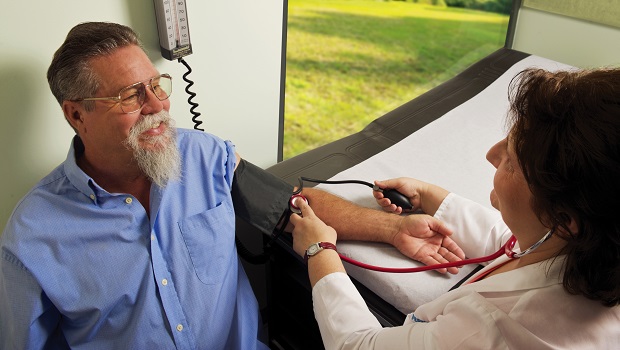Healthy Hearts Northwest helps smaller primary care clinics improve care

New study shows how a little supplemental support can result in big gains—especially in blood pressure care
With just a little bit of support, smaller primary care clinics can improve blood pressure care and lower the risk of patients’ cardiovascular disease, according to a new randomized control study from the Healthy Hearts Northwest project led by the MacColl Center for Health Care Innovation at Kaiser Permanente Washington Health Research Institute (KPWHRI).
The study, “A Randomized Trial of External Practice Support to Improve Cardiovascular Risk Factors in Primary Care,” was published in the Annals of Family Medicine.
Healthy Hearts Northwest was part of the EvidenceNOW: Advancing Heart Health initiative, which aimed to help smaller primary care practices effectively integrate evidence-based approaches to improving cardiovascular care outcomes.
The study team tested various combinations of strategies and support to discover which might improve performance on targeted clinical quality measures (CQMs) in 200 primary care clinics across Washington, Oregon, and Idaho. Approaches included use of external practice facilitators, shared learning through site visits, and virtual educational outreach. Study recruitment was limited to practices with 10 or fewer primary care providers per site and an electronic health record.
All enrolled clinics worked with a dedicated practice facilitator, or “coach,” at their locations over 15 months. Some clinics were offered, through random selection, the added support of shared learning and educational outreach. Smaller practices that received facilitation had modest improvements in their cardiovascular CQMs. And, those receiving the extra support of educational outreach and shared learning were more likely to achieve target blood pressure goals.
“We found that, practices that were offered a coach plus additional support—such as opportunities to learn from similar clinics—were most likely to reach the goal of 70 percent or more of their patients achieving good blood pressure control,” said Healthy Hearts Northwest principal investigator Michael Parchman, MD, MPH, a KPWHRI senior investigator and the paper’s lead author.
Building relationships with practice facilitators
Many clinics expressed gratitude for the help they received during the project, and the face-to-face practice facilitator visits were vital to the project’s success, Dr. Parchman said. Meeting today’s data reporting requirements is essential for staying in business but is especially difficult for smaller and rural health care practices like those in this study.
The study measured improvements of four indicators known as “ABCS”: aspirin therapy, blood pressure control, cholesterol management, and smoking cessation. Coaches then worked side-by-side with providers on quality improvement projects that included creative ways to collect and evaluate ABCS data.
L.J. Fagnan, MD, Healthy Hearts Northwest co-investigator and founding director of the Oregon Rural Practice-based Research Network said, “Smaller practices really valued the ‘at the elbow’ support they received in this study.”
Learning from similar clinics and educational outreach
A key project goal was enabling participants to learn from one another. Some clinics were offered the opportunity to visit another smaller practice with a particularly strong or innovative improvement approach. With enormous geographical spread between clinics, the study also offered virtual site visits through conference calls and webinars.
Healthy Hearts Northwest encouraged use of a cardiovascular disease risk calculator during patient encounters and used physician academic experts as educational outreach faculty for interactive training webinars and phone calls.
Achieving rural health equity
Because the project focused on smaller primary care practices, almost half of all study participants were located in rural areas. Rural practices often lack adequate staff and resources while serving lower-income patient populations compared to urban practices.
At the start of the study, rural practices struggled with adequately controlling patients’ blood pressure as compared to non-rural practices. But two years later, at the end of the study, they had closed the performance gap.
While hopeful that the Healthy Hearts approach may be effective for addressing rural health disparities, Dr. Parchman cautions that primary care practices may lack the capacity to use this model. “Additional internal resources, including databases and other technical tools, time, and people to accept the support offered, may be needed in order to improve health care quality,” he adds.
Other co-authors on the study were Melissa Anderson, MS, Ellen O’Meara, PhD, Leah Tuzzio, MPH, Robert Penfold, PhD, and Andrea J. Cook, PhD, of KPWHRI; David A. Dorr, MD, MS, and Raja Cholan, BS, of Oregon Health & Sciences University; Lyle J. Fagnan, MD, and Cullen Conway, MPH, of the Oregon Rural Practice-based Research Network; Jeffrey Hummel, MD, MPH, of Comagine Health, and Laura-Mae Baldwin, MD, MPH of the Institute of Translational Health Sciences at the University of Washington.
Healthy Hearts Northwest was supported by grant number R18HS023908 from the Agency for Healthcare Research and Quality.
By Dona Cutsogeorge
ACT Center

New center focuses on equitable, whole-person health care
Kaiser Permanente launches the Center for Accelerating Care Transformation.


